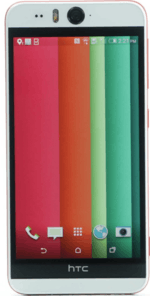HTC Desire Eye
 | |
| Manufacturer | HTC |
|---|---|
| Series | HTC Desire |
| Compatible networks | 2G, 3G, 4G |
| First released | October 2014 |
| Availability by country | November 7, 2014 |
| Type | Touchscreen smartphone |
| Form factor | Slate |
| Dimensions | 151.7 x 73.8 x 8.5 mm |
| Weight | 154 g (5.43 oz) |
| Operating system |
Original: Android 4.4.2 "KitKat" Current: Android 5.0.1 "Lollipop" |
| System on chip | Qualcomm Snapdragon 801 |
| CPU | 2.3 GHz quad-core Krait 400 |
| GPU | Adreno 330 |
| Memory | 2 GB LPDDR3 RAM |
| Storage | 16 GB flash |
| Removable storage | up to 128 GB |
| Battery | 2400 mAh |
| Data inputs | Capacitive Touch Screen, Multitouch |
| Display | 5.2 inch |
| Rear camera | 13 MP |
| Front camera | 13 MP |
| Connectivity | WLAN: Wi-Fi 802.11 a/b/g/n, dual-band, Wi-Fi Direct, DLNA, Wi-Fi hotspot, Bluetooth: v4.0, A2DP, USB: microUSB v2.0 |
| Website | http://www.htc.com/us/smartphones/htc-desire-eye/ |
The HTC Desire Eye is an Android smartphone manufactured by HTC. The phone was announced on October 8, 2014 [1] and was released on November 7, 2014 [2] exclusively for At&t in the United States and exclusively for Three in the United Kingdom.[3][4] It is known as the selfie phone because the front camera has the same quality of imaging as the rear camera.[5]
Features
The Desire Eye comes with preloaded Android 4.4 and HTC Sense 6.0.[6] An upgrade to Android 5.0.2 and Sense 7 is expected in the later part of 2015.[7]
Hardware
The Desire Eye features almost similar hardware to the flagship HTC One M8. It packs a 2.3Ghz Quad Core Qualcomm Snapdragon 801, 2 GB of RAM, a front and back 13-MP camera with dual led flash on both sides. It comes with a 2400 mAh battery and features 5.2 inch HD Display. It is equipped with two front speakers and has HTC Boom Sound in it. It also has a slot for additional memory and can take up to 128 GB.[8]
Reception
The HTC Desire Eye received positive reviews from critics. Andrew Hoyle of Cnet gave it a score 8 out of 10 and said "Its screen is bright and bold, it has plenty of power and its colourful body is waterproof.".[9] Chris Velazco of Engadget.com gave it a score of 74 out of 100 and praised the phone for its impressive performance.[10]
Despite receiving positive reviews for its performance, the Desire Eye failed at what it was marketed for. The front facing and back cameras received poor responses from critics. Jeff Parsons of TechRadar called the camera "Average" and said "The strength of the Desire Eye isn't in its 13MP cameras but its unibody design and flagship-baiting specifications.".[11]
References
- ↑ HTC desire Eye Release Date
- ↑ HTC Desire Eye Release Date
- ↑ Three gets UK exclusivity for HTC Desire Eye
- ↑ HTC Desire EYE to launch November 7th as an AT&T exclusive
- ↑ HTC Desire EYE Review: More Than Just A Selfie Phone. Forbes. November 5, 2014.
- ↑ HTC Desire Eye Review
- ↑ HTC Sense 7 teased for 2014 models earlier than expected
- ↑ HTC Desire Eye and M8
- ↑ Desire Eye review
- ↑ HTC Desire Eye Review - Engadget.com
- ↑ HTC Desire Eye review - TechRadar
External links
| |||||||||||||||||||||||||||||||||||||||||
